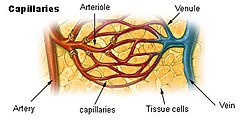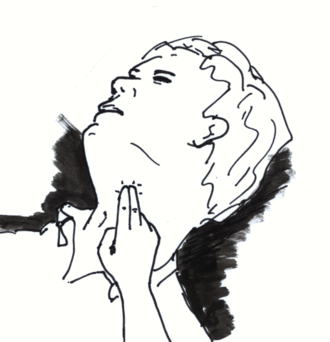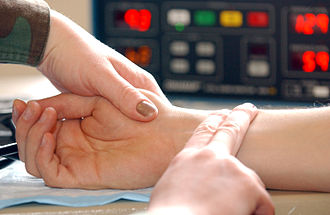Difference between revisions of "AY Honors/Heart and Circulation/Answer Key"
| Line 15: | Line 15: | ||
==3. Identify two locations for measuring your pulse. Demonstrate your ability to accurately take someone's pulse.== | ==3. Identify two locations for measuring your pulse. Demonstrate your ability to accurately take someone's pulse.== | ||
| + | [[Image:Carotidian pulse.png|thumb|left|Carotid pulse]] | ||
| + | [[Image:Radial pulse.jpg|thumb|right|Radial pulse]] | ||
| + | |||
| + | A person's pulse is the throbbing of their arteries as an effect of the heart beat. It can be felt at the neck (carotid artery), at the wrist (radial artery), behind the knee (popliteal artery), on the inside of the elbow (brachial artery), near the ankle joint (posterior tibial artery), and a few other places. | ||
| + | |||
| + | The easiest places to detect the pulse are at the neck and wrist. To detect it at the neck, place the index and middle fingers side-by-side on the next just below the corner of the jawbone. To detect it at the wrist, place them side-by-side on the smooth side of the wrist {{units|a few centimeters|about an inch}} below the thumb. Do not use the thumb to take the pulse, as the pulse can be detected in the thumb itself which can interfere with the pulse one is attempting to measure. | ||
| + | <br style="clear:both"> | ||
| + | |||
==4. Record your resting pulse rate, then exercise strenuously (ie jog, swim laps, climb stairs, etc.) for 10 minutes. Retake your pulse immediately after exercising, and then again after five minutes. Do this each day for one week recording your results on a chart or a graph. Did the exercise effect your heart rate?== | ==4. Record your resting pulse rate, then exercise strenuously (ie jog, swim laps, climb stairs, etc.) for 10 minutes. Retake your pulse immediately after exercising, and then again after five minutes. Do this each day for one week recording your results on a chart or a graph. Did the exercise effect your heart rate?== | ||
==5. Make a simple stethoscope and listen so someone’s heart beat.== | ==5. Make a simple stethoscope and listen so someone’s heart beat.== | ||
Revision as of 16:48, 24 October 2007
1. Describe the basic function of the following parts of the circulatory system: heart, blood vessels, blood, and lungs.
- Heart
- The heart is a muscular organ responsible for pumping blood through the blood vessels.
- Blood Vessels
- The blood vessels are like tubes inside the body though which blood flows. They function to transport blood throughout the body.
- Blood
- Blood is a specialized fluid consisting of red blood cells, white blood cells, and platelets suspended in a complex fluid medium known as blood plasma. Blood plasma is the liquid component of blood, in which the blood cells are suspended. It makes up a little more than half of total blood volume. By far the most abundant cells in blood are red blood cells. Red blood cells carry oxygen to all the other cells in the body and carry carbon dioxide (and other wastes) away from them. White blood cells help to resist infections, and platelets are important in the clotting of blood.
- Lungs
- The principal function of the lungs is to transport oxygen from the atmosphere into the bloodstream, and to get rid of carbon dioxide from the bloodstream into the atmosphere.
2. Describe the major difference between arteries and veins. What is a capillary and what is its function?
Arteries are muscular blood vessels that carry blood away from the heart. All arteries, with the exception of the pulmonary and umbilical arteries, carry oxygenated blood.
Veins are blood vessels that carry blood toward the heart. The majority of veins in the body carry low-oxygen blood from the tissues back to the heart; the exceptions being the pulmonary and umbilical veins which both carry oxygenated blood.
Capillaries are the smallest of a body's blood vessels, measuring 5-10 μm, and are important for the interchange of oxygen, carbon dioxide, and other substances between blood and tissue cells. The walls of capillaries are composed of only a single layer of cells, the endothelium. This layer is so thin that molecules such as oxygen, water and lipids can pass through them by diffusion and enter the tissues. Waste products such as carbon dioxide and urea can diffuse back into the blood to be carried away for removal from the body. Capillaries are so small the blood cells need to pass through it in a single file line. Capillaries carry blood from the arteries to the veins.
3. Identify two locations for measuring your pulse. Demonstrate your ability to accurately take someone's pulse.
A person's pulse is the throbbing of their arteries as an effect of the heart beat. It can be felt at the neck (carotid artery), at the wrist (radial artery), behind the knee (popliteal artery), on the inside of the elbow (brachial artery), near the ankle joint (posterior tibial artery), and a few other places.
The easiest places to detect the pulse are at the neck and wrist. To detect it at the neck, place the index and middle fingers side-by-side on the next just below the corner of the jawbone. To detect it at the wrist, place them side-by-side on the smooth side of the wrist a few centimeters![]() below the thumb. Do not use the thumb to take the pulse, as the pulse can be detected in the thumb itself which can interfere with the pulse one is attempting to measure.
below the thumb. Do not use the thumb to take the pulse, as the pulse can be detected in the thumb itself which can interfere with the pulse one is attempting to measure.



